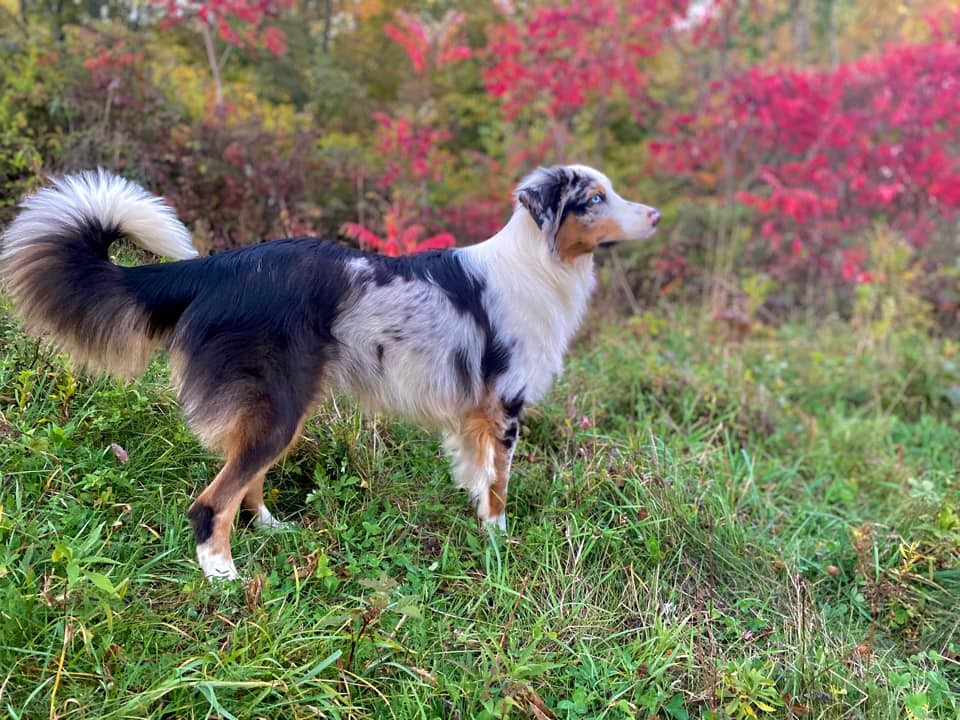
The Australian Shepherd breed presents a unique case study in canine tail genetics and modification practices. While traditionally known for docked or naturally bobbed tails, approximately 80% of Australian Shepherds are born with full-length tails. The natural bobtail (NBT) trait occurs in about 20% of the breed due to a dominant gene mutation. Current breed standards in major kennel clubs require tails not exceeding 4 inches, achieved either through docking or natural bobtails. However, with increasing global restrictions on tail docking, understanding the genetics and implications of tail variations has become crucial for breeders and breed organizations worldwide.
Australian Shepherd Tail Variations and Characteristics
Natural Tail Length Distribution
According to registration statistics, over 50% of Australian Shepherds are born with full-length, fluffy tails. Approximately 20% are born with naturally bobbed tails (NBT). Among NBT Aussies, around 47% have quarter-length or longer tails, while 10% exhibit kinked tails. The exact tail length in NBT dogs is variable and depends on individual genetics.
Tail Conformation Patterns
Based on comprehensive survey data from ASHGI, 58% of undocked Aussies display a slightly curved tail shape. Regarding tail feathering, 61% show profuse feathering at the base that gradually shortens toward the tip. Tail carriage varies, with 32% carrying tails slightly below the topline, 24% slightly above, and 21% level with the topline. High tail carriage over the back is uncommon in the breed. These natural tail characteristics provide important guidance for breed standards in regions where docking is prohibited.
Natural Tail Genetics and Inheritance\nTail Types and Characteristics
NBT Gene Inheritance Pattern
The natural bobtail (NBT) gene in Australian Shepherds follows an incomplete dominant inheritance pattern, similar to the merle gene. Dogs inheriting one copy (N/BT genotype) will display a naturally bobbed tail, with the ability to pass this trait to 50% of their offspring. However, puppies inheriting two copies of the NBT gene typically do not survive gestation and are reabsorbed, resulting in reduced litter sizes. The rare survivors with double NBT genes often have severe spinal defects requiring euthanasia.
Health Considerations in NBT Breeding
According to breed specialists, breeding two NBT carriers together is strongly discouraged due to significant health risks. About 2% of breeding dogs have reported producing NBTs with severe defects necessitating euthanasia. The risk increases particularly when breeding very short NBTs together. DNA testing through T-box gene analysis can identify NBT carriers, allowing breeders to make informed decisions. Health issues associated with NBT genetics include spina bifida, perianal closure failures, and varying degrees of hindquarter paralysis. While the previous section focused on physical tail characteristics, this section emphasizes the genetic mechanisms and associated health implications of natural bobtails.
Tail Docking Regulations and Practices
Global Legal Status
While tail docking remains legal in most U.S. states, with only Maryland and Pennsylvania having restrictions, many countries have banned the practice. It is prohibited in Australia and several European nations including Germany, Denmark, and the Netherlands. The Canadian Veterinary Medical Association considers tail docking as medically unnecessary and ethically unacceptable, though it remains legal in most provinces.
Health Impact of Docking
Recent studies indicate that tail docking can cause significant issues in Australian Shepherds. While traditionally believed to be painless in newborns, research shows puppies actually have more neurological transmitters than adult dogs, suggesting heightened pain sensitivity. Documented effects include increased weight loss, stunted development, and higher infection risks in docked litters compared to undocked ones. Long-term consequences may include impacts on the central nervous system development and underdeveloped pelvic muscles, though evidence for the latter remains inconclusive. While previous sections covered natural tail characteristics and genetics, this section specifically addresses the regulatory landscape and health implications of tail docking practices.
Conclusion
Research reveals that Australian Shepherds naturally exhibit diverse tail characteristics, with over 50% born with full-length tails and approximately 20% having natural bobtails (NBT). The genetics behind NBT follow an incomplete dominant inheritance pattern, with significant health implications when breeding two NBT carriers together. Most undocked Aussies display slightly curved tails with profuse feathering, carried at or slightly below the topline.
The findings have important implications for breeding practices and animal welfare. While tail docking remains legal in most U.S. states, it is banned in numerous countries due to welfare concerns and evidence of potential negative health impacts. This suggests a growing need for breeders to understand natural tail genetics and characteristics, particularly in regions where docking is prohibited. DNA testing for NBT carriers can help inform responsible breeding decisions to avoid health complications while preserving natural tail variations in the breed.